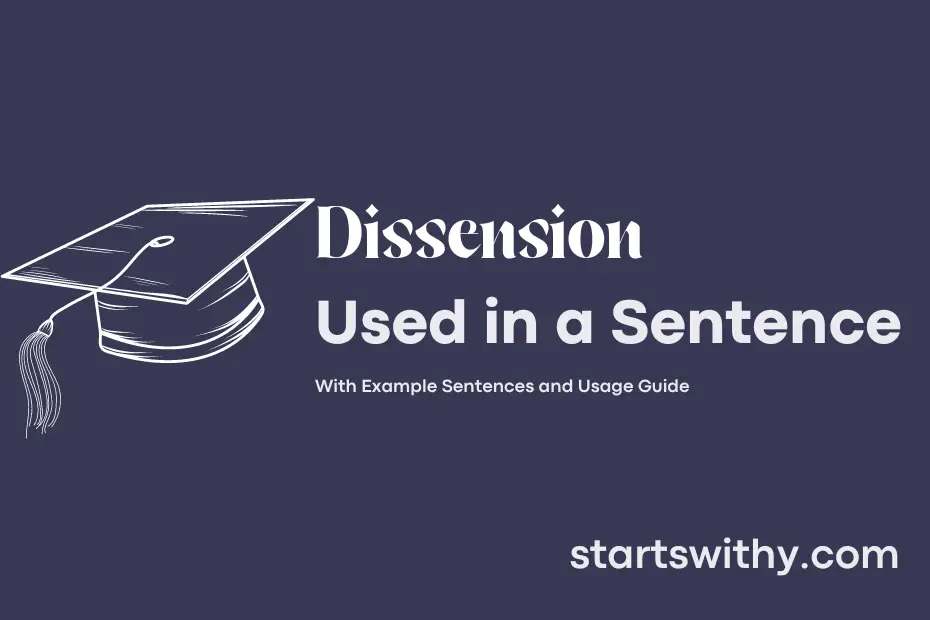Dissension, representing disagreement or discord within a group, can manifest in various forms and impact the overall dynamics and productivity of any collective effort. This disagreement may arise from differing opinions, beliefs, or goals among members involved in a common endeavor.
Effective communication and conflict resolution techniques are crucial in managing dissension and promoting cohesion within a group. Addressing conflicts promptly and respectfully, seeking compromise, and fostering a culture of open dialogue can help mitigate the negative effects of dissension and lead to greater harmony and collaboration among team members.
7 Examples Of Dissension Used In a Sentence For Kids
- Dissension means when people don’t agree.
- Let’s try to solve problems without dissension.
- It’s important to listen to each other to avoid dissension.
- Kindness can help reduce dissension.
- We should always try to be friends and not have dissension.
- Saying sorry can help stop dissension.
- Let’s work together and have fun instead of dissension.
14 Sentences with Dissension Examples
- Dissension rose among the classmates during the debate competition.
- The student council meeting was filled with dissension regarding the budget allocation for cultural events.
- Dissension emerged within the college political science department over differing opinions on foreign policy.
- The group project faced dissension as members couldn’t agree on the best approach to take.
- Dissension erupted in the cultural club over conflicting ideas for the annual fest.
- The debate club faced dissension as members argued over the topic for the upcoming tournament.
- Dissension arose among the students on the choice of guest speaker for the college seminar.
- The election for the student body president led to dissension among the candidates’ supporters.
- The dissension between the science and arts students led to a heated discussion during the college fest.
- Dissension was palpable within the college sports team as players disagreed on the training schedule.
- The seminar on social issues sparked dissension among the attendees who had differing opinions on the topic.
- Dissension flared up during the college magazine editorial meeting over the selection of articles for the next issue.
- The decision to change the college dress code caused dissension among the student body.
- Dissension arose between the college faculty and administration regarding the implementation of new academic policies.
How To Use Dissension in Sentences?
Dissension is used in a sentence to describe disagreements or disputes within a group or organization. To use dissension correctly, identify a situation where there is a conflict of opinions or interests among the members involved. For example, “The board meeting was filled with dissension as members argued over the budget allocation.”
When constructing a sentence with dissension, consider the context in which the word is being used. It is essential to convey the idea of discord or disagreement clearly. You can use dissension in both formal and informal writing, such as academic papers, reports, or casual conversations, to describe conflicts within a group.
Remember to place dissension appropriately within the sentence structure. It can be the main focus of the sentence or used to provide additional information. For instance, “The team’s inability to reach a consensus led to increased dissension among its members.”
By practicing using dissension in various contexts, you can improve your understanding of the word and effectively communicate instances of disagreement or conflict. Keep in mind that dissension is a powerful term that conveys tension and division within a group, making it a valuable addition to your vocabulary.
Conclusion
In conclusion, dissension refers to disagreement or conflict among a group of people. Throughout history, many conflicts and debates have stemmed from dissension among individuals or groups. It often arises from differing opinions, beliefs, or interests, leading to tension and discord. In order to resolve dissension and promote unity, open communication, compromise, and mutual respect are essential.
Addressing dissension constructively can lead to positive outcomes, including the exchange of ideas, growth, and innovation. By fostering an environment where diverse viewpoints are valued and conflicts are resolved peacefully, groups can harness the potential benefits of dissension while avoiding its negative consequences. Ultimately, embracing and managing dissension effectively can lead to improved relationships, better decision-making, and a stronger sense of unity among individuals or within a community.



